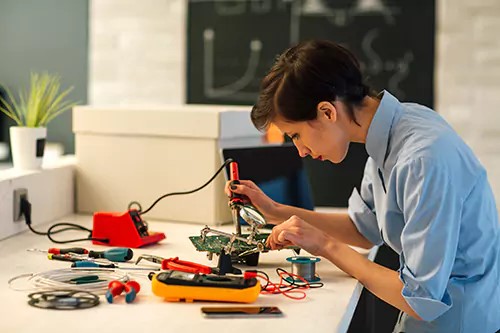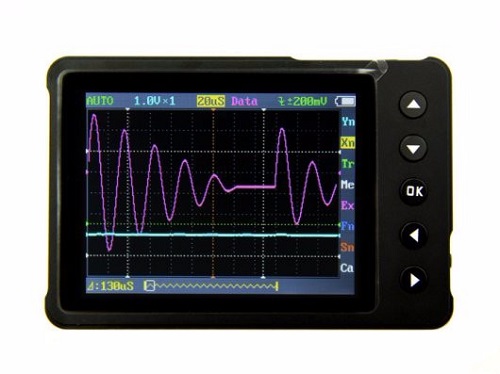By Rudy Ramos, Mouser Electronics
Whether you’re an electronics hobbyist or involved in cutting-edge new product design, it’s essential that you have the right test equipment. Most test benches contain a range of testing equipment that’s been handed down through generations or shared between technicians. This means that the equipment being used for a given purpose isn’t always the best option.
Choosing the right test equipment isn’t about picking the tool with the most features or highest price tag, however. It’s about choosing something appropriate for your testing needs and electronics experience.
We’ve put together this guide to help you make the best possible choices when selecting equipment. We’ll look at some core pieces of testing equipment, something to think about when you’re buying, and how your equipment should evolve as you become more skilled and your requirements become more sophisticated.
Here’s the core equipment that should be part of your electronics test bench regardless of level:
- Multimeters: Sometimes called a volt-ohm-milliammeter, or VOM, the multimeter is a core part of the electronics bench. It enables you to check a range of measurements, including AC and DC voltage (V), resistance, continuity, and direct current (DC). You need to choose one that meets your needs, is easy to use, and is accurate.
- Power supplies: Whether you’re looking to deliver power to a circuit you’ve just designed, or any board, a reliable DC power source is essential. These deliver a reliable voltage and are often settable, enabling you to develop and test circuits in a variety of conditions.
- Soldering stations: These allow you to create circuits by linking up components and to repair PCBs. As a minimum, a soldering station needs a power unit, soldering pencil, a stand, and a sponge (for cleaning the soldering tip).
- Oscilloscopes: Sometimes called “O-scopes,” these measure changes in electrical signals over time and display them as waveforms that showcase information such as the rise time, distortion, frequency, amplitude, and noise.
- Accessories: These include different hand tools and supplies that help keep you safe and make your testing work easier.

Fig. 1: A relatively basic electronics bench setup is often all you need for many repairs to printed circuit boards.
While every test bench should have these types of equipment, there are many options available for each type, varying in such things as cost, precision, and feature set. The best combination will depend on the level at which you are working.
A “basic,” or entry-level, test bench is perfect for students and hobbyists who tinker with a broad range of electronics — from audio to robotics. If this sounds like you, then an entry-level test bench should be adequate. The test equipment should be easy to use and not create any barriers that slow your progress. It goes without saying, of course, that the equipment must meet your testing needs.
Here’s what you should be considering:
Entry-level multimeters
For basic test benches, a handheld digital multimeter (DMM) is ideal. They’re portable and affordable while being simpler to read and more accurate than analog versions because there’s no chance for parallax error when taking readings. Parallax error is the perceived change in the position of something when you look at it from different angles, as can happen with a needle on a meter. The lack of moving parts in a DMM also means that they’re typically more robust than analog meters. Lastly, DMMs don’t require you to calculate exact values.
When choosing a handheld DMM, consider what display resolution you need and how many digits it can show. Also, look to see if there are other features. Can it measure true root mean square (RMS) AC volts? Can it measure temperature?
Both the Extech EX300 Series Digital Multimeters and B&K Handheld Digital Multimeters are good examples of handheld DMMs for basic test benches.
Entry-level power supplies
For basic test benches, we suggest that you go for a switch-mode DC power supply (SMPS). This has a switching regulator that controls the conversion from AC power to DC. While SMPSs usually generate high-frequency noise that may affect nearby sensitive electronics, their benefits for basic test bench needs generally outweigh this drawback.
Other SMPS advantages include the fact that they’re smaller and lighter than linear power supplies and are more efficient, meaning that they don’t heat up as much as linear versions.
It’s a good idea to choose a variable-voltage supply that can deliver up to 10 A and 30 V. This will ensure that you have sufficient capacity to cover a range of power requirements.
Two good examples of DC power supplies are the Global Specialties 1415 Dual Output DC Power Supply and B&K’s Precision 1747 Dual Range DC Power Supply.
Entry-level soldering stations
For a basic bench, go for something with a variable temperature control, up to the 450–550°C range. Analog temperature control should be okay for most people, but if you do want very high precision, there are digital options available, too.
Either the WD1002 95W Soldering Workstation or WES51 50W Soldering Workstation from Apex Tool Group are excellent choices for a basic test bench.
Entry-level oscilloscopes
For many hobbyists or electronics students who need to test circuits, a handheld DMM is sufficient. But when you start to debug and troubleshoot circuits or work with signals involving fast circuits, pulse signals, or buses, an oscilloscope becomes extremely useful.
Oscilloscopes are on the pricey side compared to other entry-level test bench gear, so unless you need to troubleshoot a circuit (rather than just measure it), it needn’t be at the top of your shopping list. If you do need one, though, go for a portable product, such as Seeed Studio’s DSO Nano V3, a 32-bit digital storage O-scope with a built-in signal generator.

Fig. 2: Oscilloscopes are not always necessary in an entry-level test bench, but if they are needed, the DSC Nano V3 from Seeed Studio is a good choice.
Entry-level accessories
To round off your test bench setup, get yourself an electrostatic mat and wrist strap to ground yourself and protect the components you’re working on from electrostatic discharge. Also have tools such as wire cutters and strippers, crimpers, tweezers, and screwdrivers readily available.
The products recommended here, or equivalent units from other vendors, are suitable for the relatively undemanding requirements of the hobbyist, beginning student, and tinkerer. If you’re an educator, electronics maintenance and repair professional, or a more advanced hobbyist or student, however, you’ll need a more sophisticated test bench. And for those working at the top end of electronics design, certified electronics professionals, or anyone needing to guarantee their repair work or needing to comply with standards, a top-end test bench is a must-have. We’ll discuss mid-level and top-end test bench requirements in a follow-on article.
Advertisement
Learn more about Mouser Electronics





